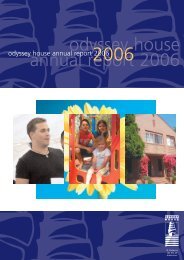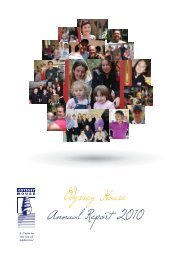ATS Literature Review, Consultations & Trial - Odyssey House
ATS Literature Review, Consultations & Trial - Odyssey House
ATS Literature Review, Consultations & Trial - Odyssey House
Create successful ePaper yourself
Turn your PDF publications into a flip-book with our unique Google optimized e-Paper software.
Amphetamine‐Type Stimulants: Development of a Treatment Protocol<br />
associated with <strong>ATS</strong> use; the management of co‐existing anxiety and depression; and the<br />
management of severely dependent <strong>ATS</strong> users who are resistant to standard interventions.<br />
3.1. Characteristics of methamphetamine users entering treatment<br />
The Center for Substance Abuse Treatment in the US funded the Methamphetamine Treatment<br />
Project to evaluate and compare treatment approaches for methamphetamine users. As part of this<br />
study, drug use patterns, history of physical and sexual abuse, history of suicidality and<br />
psychopathology were assessed in 1016 methamphetamine clients between 1999 and 2001 across<br />
eight sites (Christian, Huber, Brecht, et.al., 2007). Of the 1016 participants, 55% were female and<br />
45% were male. The mean age was 32.8 (SD=8.0 years) and participants reported using for a mean<br />
of 11 years (SD=7.7 years), with 5 of these years recognised as frequent or problematic use.<br />
The study found that participants struggled with psychological issues, including depression and<br />
anxiety symptoms. Twenty‐six percent had symptoms which were severe enough to have required<br />
admission to a psychiatric facility, 32% had been on prescribed psychiatric medications at some<br />
point in their lives and 19% reported visual or auditory hallucinations. Sixty percent of participants<br />
in this study had suffered from depression at some point in their lives, 34% admitted to thoughts of<br />
suicide and 21% had attempted suicide at some point in their lifetime (Christian, et.al., 2007).<br />
Another significant factor for many <strong>ATS</strong> users is sexual abuse, and this study found 20% of both men<br />
and women had been sexually abused. A total of 39% of the total sample, and 58% of the women<br />
also reported having been forced to engage in sex. Participants admitting to sexual abuse also<br />
demonstrated significantly more psychological distress and scored more highly on psychotic‐like<br />
thinking, anxiety, depression, suicidal ideation, and suicide attempts than those without a history of<br />
abuse (Christian, et.al., 2007).<br />
Baker, Boggs and Lewin (2001), in their study of 64 regular amphetamine users in Newcastle (NSW,<br />
Australia), found high levels of psychopathology, social dysfunction, criminal behaviour, poor health<br />
and high levels of unemployment. The Opiate Treatment Scale, amphetamine version of the<br />
Severity of Dependence Scale and the Contemplation Ladder (to determine stage of change) were<br />
administered.<br />
Although 40.6% of subjects reported being at the preparation or action phase, the majority of<br />
subjects were at earlier stages, indicating a need for a range of interventions to be available for<br />
users at different stages. It is suggested that clients in the precontemplation and contemplation<br />
stages may be best accessed via needle and syringe programs or primary health care, where brief<br />
interventions may be delivered with harm reduction goals (Baker, et.al., 2001).<br />
Currently, the National Drug and Alcohol Research Centre (NDARC) is conducting the first Australian<br />
longitudinal cohort study of dependent methamphetamine users. The Methamphetamine<br />
Treatment Evaluation Study (MATES) is examining:<br />
• Rates of psychiatric disorders and psychotic symptoms among people seeking treatment for<br />
methamphetamine dependence. This includes Major Depression, Panic Disorder,<br />
Agoraphobia, Social Phobia, and Generalized Anxiety Disorder;<br />
• The characteristics of those entering treatment for methamphetamine dependence.<br />
Information included in the study relates to abstinence rates, criminal involvement, general<br />
health functioning and contact with health services and the criminal justice system;<br />
Page 36 © Lynne Magor‐Blatch & James A. Pitts: <strong>Odyssey</strong> <strong>House</strong> McGrath Foundation 2008‐2009








